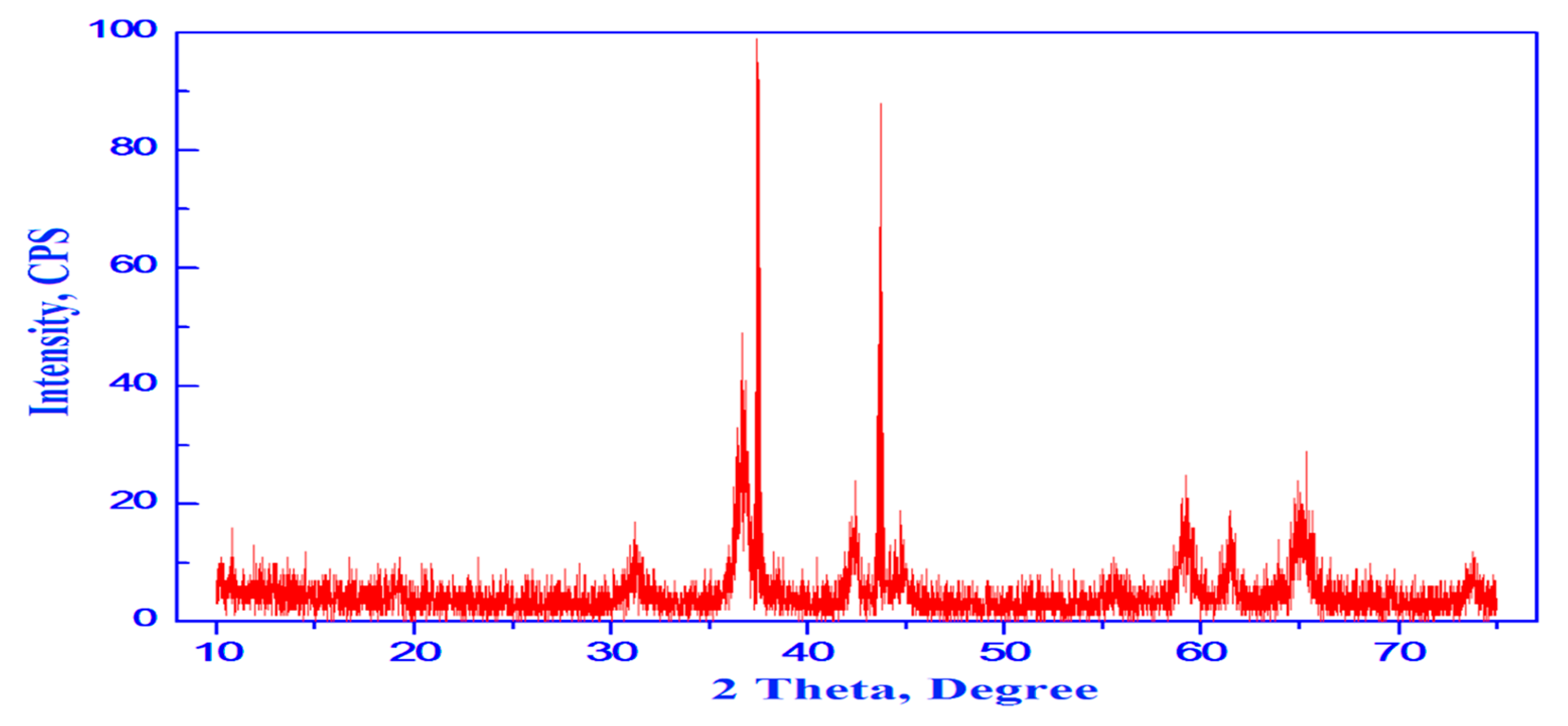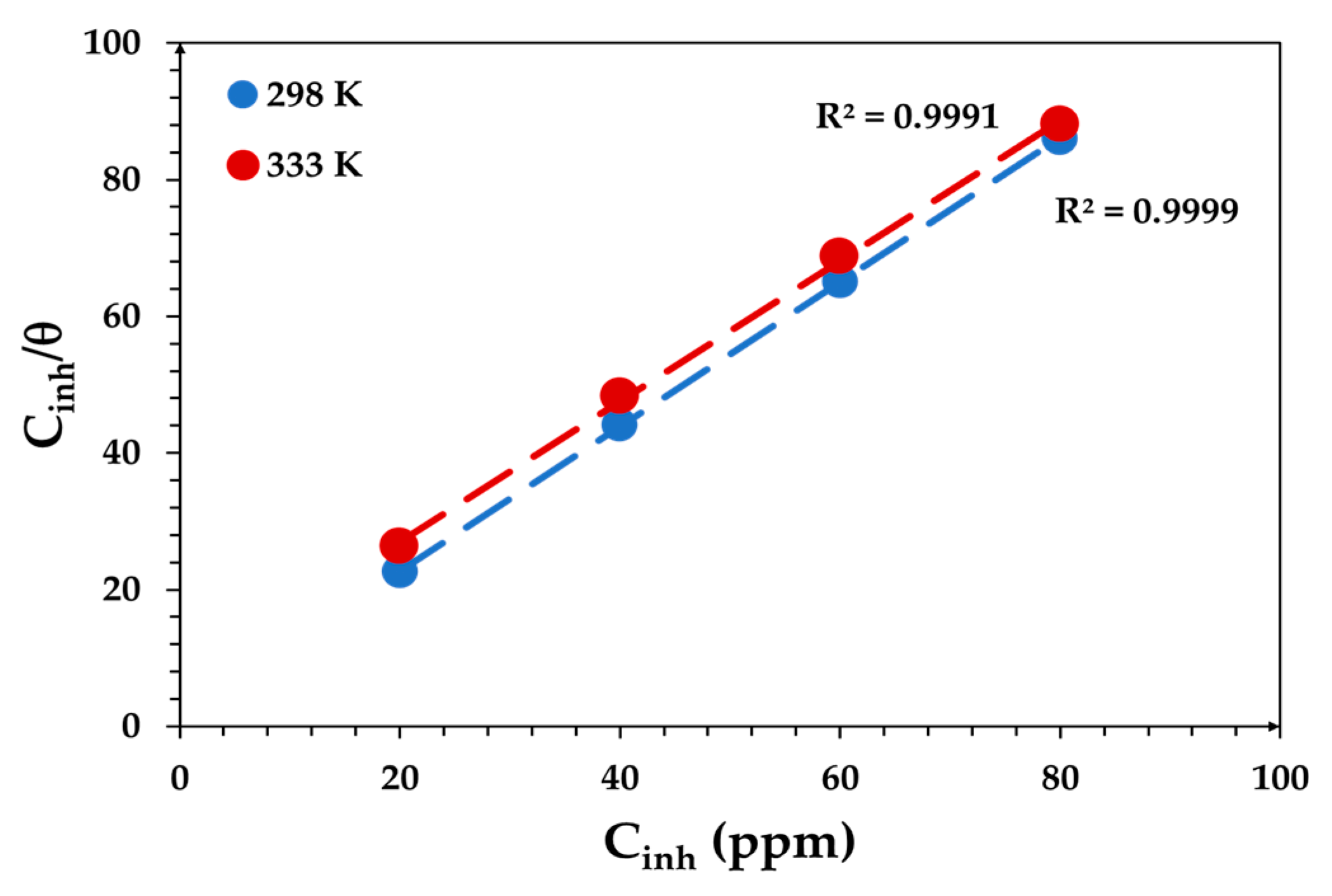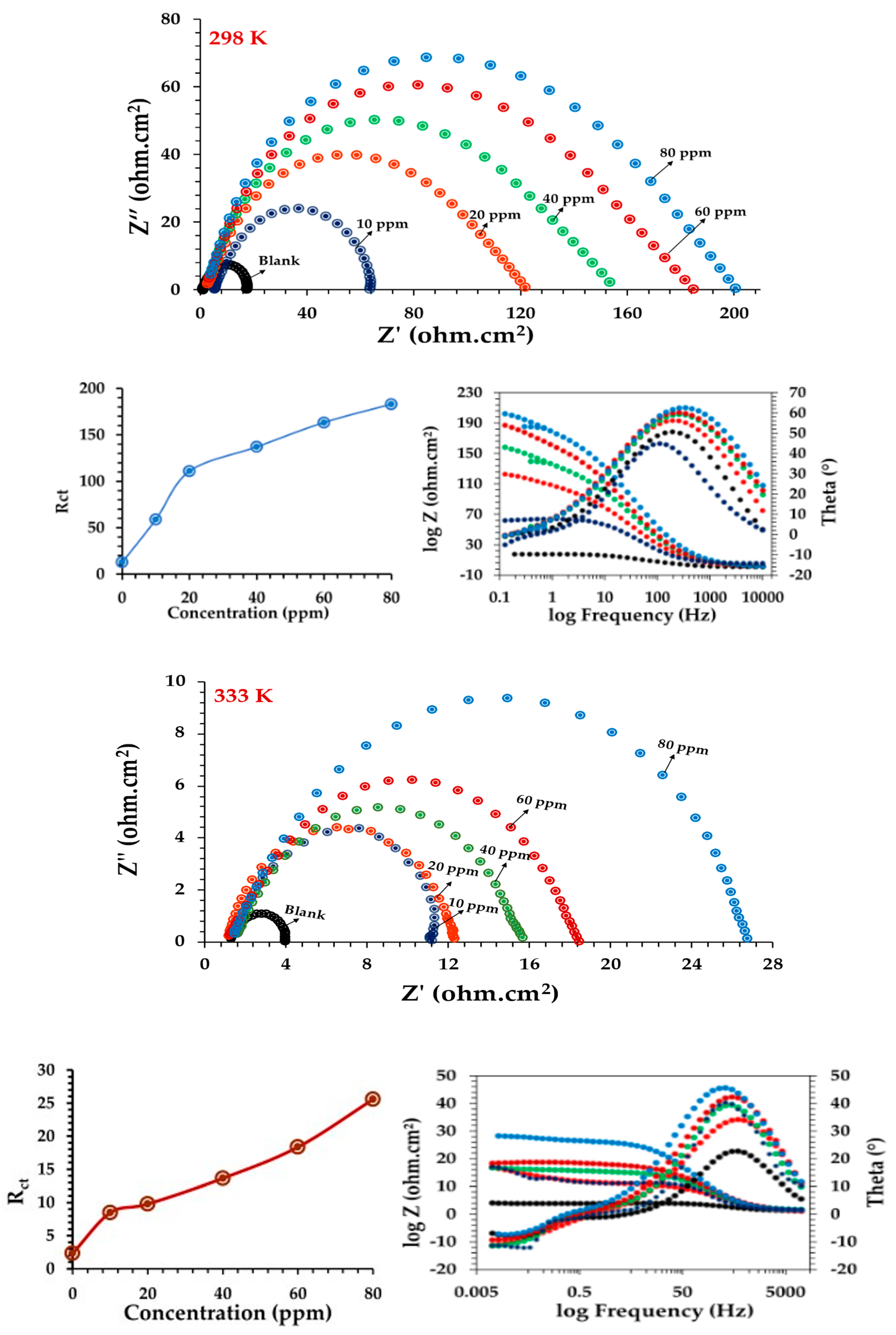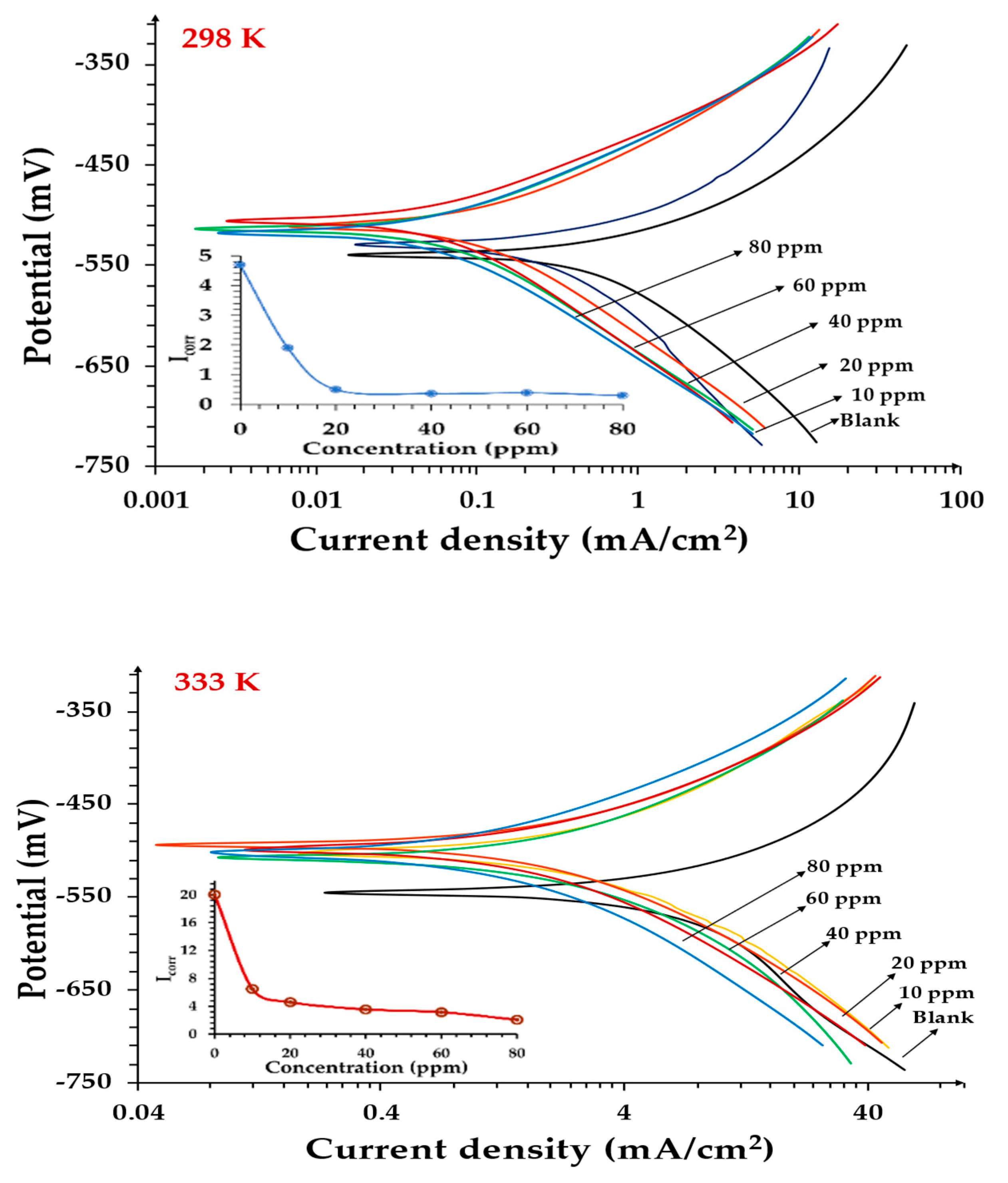The Use of Synthesized CoO/Co3O4 Nanoparticles as A Corrosion Inhibitor of Low-Carbon Steel in 1 M HCl
Abstract
:1. Introduction
2. Experimental Setup
2.1. Materials
2.2. Synthesis of CoO/Co3O4 NPs
2.3. Solution Preparation
2.4. Low-Carbon Steel Specimen Preparation
2.5. Electrochemical Measurements
- EIS:
- PDP:
2.6. The Surface Morphology Study
3. Results and Discussion
3.1. Characterization of CoO/Co3O4 NPs
3.2. Mechanism of Adsorption of Inhibitors on Low-Carbon Steel Surface
- The electrostatic attraction occurs between the charged metal and the charged damper particles.
- A coordinated bond is formed between the free electron pairs in the inhibitor molecules and the vacant d-orbitals of the iron on the metal surface.
- The electron donation and electron attraction reaction occur between the inhibitor particles and the metal.
- All previous interactions.
3.3. Determination of Thermodynamic Parameters and Adsorption Isotherm
3.4. Electrochemical Measurements
3.4.1. The Electrochemical Impedance Technique
3.4.2. The Potentiodynamic Polarization Technique
3.5. Scanning Electron Microscopy (SEM), Energy-Dispersive X-ray Spectroscopy (EDS) and X-ray Electron Spectroscopy
4. Conclusions
Author Contributions
Funding
Institutional Review Board Statement
Informed Consent Statement
Data Availability Statement
Acknowledgments
Conflicts of Interest
References
- Veselov, I.N.; Pyshmintsev, I.Y.; Laev, K.A.; Zhukova, S.Y. Structure and mechanical properties of low-carbon steel for oil and gas pipelines. Steel Transl. 2011, 41, 165–170. [Google Scholar] [CrossRef]
- Enani, J. Corrosion control in oil and gas pipelines. Int. J. Sci. Eng. Res. 2016, 7, 1161–1164. [Google Scholar]
- Poletskov, P.; Gushchina, M.; Polyakova, M.; Alekseev, D.; Nikitenko, O.; Chukin, D.; Vasil’ev, Y. Development of Alloyed Pipe Steel Composition for Oil and Gas Production in the Arctic Region. Resources 2019, 8, 67. [Google Scholar] [CrossRef] [Green Version]
- Al-Senani, G.M. Synthesis of ZnO-NPs Using a Convolvulus arvensis Leaf Extract and Proving Its Efficiency as an Inhibitor of Carbon Steel Corrosion. Materials 2020, 13, 890. [Google Scholar] [CrossRef] [Green Version]
- Al-Senani, G.M.; Alshabanat, M. Study the Corrosion Inhibition of Carbon Steel in 1 M HCl Using Extracts of Date Palm Waste. Int. J. Electrochem. Sci. 2018, 13, 3777–3788. [Google Scholar] [CrossRef]
- Al-Senani, G.M.; AL-Saeedi, S.; AL-Mufarij, R. Coriandrum sativum leaves extract (CSL) as an eco-friendly green inhibitor for corrosion of carbon steel in acidic media. J. Mater. Environ. Sci. 2016, 7, 2240–2251. [Google Scholar]
- Al-Sabagh, A.M.; Abd-El-Bary, H.M.; El-Ghazawy, R.A.; Mishrif, M.R.; Hussein, B.M. Corrosion inhibition efficiency of linear alkyl benzene derivatives for carbon steel pipelines in 1M HCl. Egypt. J. 2011, 20, 33–45. [Google Scholar] [CrossRef] [Green Version]
- Galaia, M.; El Gouri, M.; Dagdagc, O.; El Kacimia, Y.; Elharfic, A.; Ebn Touhamia, M. New Hexa Propylene Glycol Cyclotiphosphazene As Efficient Organic Inhibitor of Carbon Steel Corrosion in Hydrochloric Acid Medium. J. Mater. Environ. Sci. 2016, 7, 1562–1575. [Google Scholar]
- Li, D.; Zhang, P.; Guo, X.; Zhao, X.; Xu, Y. The inhibition of mild steel corrosion in 1 M HCL solution by radish leaf extract. RSC Adv. 2019, 9, 40997–41009. [Google Scholar] [CrossRef] [Green Version]
- Jawad, Q.A.; Zinad, D.S.; Salim, R.D.; Al-Amiery, A.A.; Gaaz, T.S.; Takri, M.S.; Kadhum, A.H. Synthesis, Characterization, and Corrosion Inhibition Potential of Novel Thiosemicarbazone on Mild Steel in Sulfuric Acid Environment. Coatings 2019, 9, 729. [Google Scholar] [CrossRef] [Green Version]
- Iribarren, A.; Rivero, P.J.; Berlanga, C.; Larumbe, S.; Miguel, A.; Palacio, J.V.; Rodriguez, R. Multifunctional Protective PVC-ZnO Nanocomposite Coatings Deposited on Aluminum Alloys by Electrospinning. Coatings 2019, 9, 216. [Google Scholar] [CrossRef] [Green Version]
- Fayemia, O.E.; Adekunlea, A.S.; Swamyd, B.E.K.; Ebenso, E.E. Electrochemical sensor for the detection of dopamine in real samples using polyaniline/NiO, ZnO, and Fe3O4 nanocomposites on glassy carbon electrode. J. Electroanal. Chem. 2018, 818, 236–249. [Google Scholar] [CrossRef]
- Loto, R.T. Surface coverage and corrosion inhibition effect of Rosmarinus officinalis and zinc oxide on the electrochemical performance of low carbon steel in dilute acid solutions. Results Phys. 2018, 8, 172–179. [Google Scholar] [CrossRef]
- Islam, T.; Rosales, J.; Saenz-Arana, R.; Arrieta, R.; Kim, H.; Sultana, K.A.; Lin, Y.; Villagran, D.; Noveron, J.C. Synthesis of high surface area transition metal sponges and their catalytic properties Md. New J. Chem. 2019, 43, 10045–10055. [Google Scholar] [CrossRef]
- Geethamani, P. Corrosion Inhibitors. In Corrosion Inhibitors; Singh, A., Ed.; SW7 2QJ; IntechOpen: London, UK, 2019; Available online: https://www.intechopen.com/books/corrosion-inhibitors/corrosion-inhibitors (accessed on 23 July 2019). [CrossRef] [Green Version]
- Borghei, S.M.; Bakhtiyari, F. Study of the Physical Properties of Cobalt/Cobalt Oxide Particles Synthesized by Pulsed Laser Ablation in Different Liquid Media. Acta Phys. Pol. A 2017, 131, 332–335. [Google Scholar] [CrossRef]
- Dai, Q.; Tang, J. The optical and magnetic properties of CoO and Co nanocrystals prepared by a facile technique. Nanoscale 2013, 5, 7512. [Google Scholar] [CrossRef]
- Nassar, A.M.; Hassan, A.M.; Shoeib, M.; El Kmash, A.N. Synthesis, Characterization and Anticorrosion Studies of New Homobimetallic Co(II), Ni(II), Cu(II), and Zn(II) Schiff Base Complexes. J. Bio- Tribo-Corros. 2015, 1, 19. [Google Scholar] [CrossRef] [Green Version]
- Al-Jubanawi, I.M.; Al-Sawaad, H.Z.; AlWaaly, A.A. Bis thiourea phthalato Cobalt (Ⅱ) complex: Synthesis and studying as corrosion inhibitors for carbon steel alloy(C1010) in 0.1M HCl. J. Mater. Environ. Sci. 2020, 11, 1386–1402. [Google Scholar]
- Keles, H.; Emir, D.M.; Keleş, M. A comparative study of the corrosion inhibition of low carbon steel in HCl solution by an imine compound and its cobalt complex. Corros. Sci. 2015, 101, 19–31. [Google Scholar] [CrossRef]
- Al-Senani, G.M.; Deraz, N.M.; Abd-Elkader, O.H. Magnetic and Characterization Studies of CoO/Co3O4 Nanocomposite. Processes 2020, 8, 844. [Google Scholar] [CrossRef]
- Rostami, M.; Rasouli, S.; Ramezanzadeh, B.; Askari, A. Electrochemical investigation of the properties of Co doped ZnO nanoparticle as a corrosion inhibitive pigment for modifying corrosion resistance of the epoxy coating. Corros. Sci. 2014, 88, 387–399. [Google Scholar] [CrossRef]
- Jafari, H.; Akbarzade, K.; Danaee, I. Corrosion inhibition of carbon steel immersed in a 1M HCl solution using benzothiazole derivatives. Arab. J. Chem. 2019, 12, 1387–1394. [Google Scholar] [CrossRef] [Green Version]
- Yahya, S.; Othman, N.K.; Daud, A.R.; Jalar, A. The inhibition of carbon steel corrosion by lignin in HCl and H2SO4. AIP Conf. Proc. 2013, 1571, 132. [Google Scholar] [CrossRef] [Green Version]
- Ituen, E.; Singh, A.; Yuanhua, L.; Akaranta, O. Green synthesis and anticorrosion effect of Allium cepa peels extract-silver nanoparticles composite in simulated oilfield pickling solution. SN Appl. Sci. 2021, 3, 679. [Google Scholar] [CrossRef]
- Borhani, S.; Moradi, M.; Kiani, M.A.; Hajati, S.; Toth, J. CoxZn1_x ZIF-derived binary Co3O4/ZnO wrapped by 3D reduced graphene oxide for asymmetric supercapacitor: Comparison of pure and heat-treated bimetallic MOF. Ceram. Int. 2017, 43, 14413–14425. [Google Scholar] [CrossRef]
- Shahzad, K.; Sliem, M.H.; Shakoor, R.A.; Radwan, A.B.; Kahraman, R.; Umer, M.A.; Manzoor, U.; Abdullah, A.M. Electrochemical and thermodynamic study on the corrosion performance of API X120 steel in 3.5% NaCl solution. Sci. Rep. 2020, 10, 4314. [Google Scholar] [CrossRef]
- Akinbulumo, O.A.; Odejobi, O.J.; Odekanle, E.L. Thermodynamics and adsorption study of the corrosion inhibition of mild steel by Euphorbia heterophylla L. extract in 1.5 M HCl. Results Mater. 2020, 5, 100074. [Google Scholar] [CrossRef]
- Er, M. Synthesis of Silver Nanoparticles using a Plasma-Liquid Process; Chemical Physics [physics.chem-ph]. NNT: 2019USPCD001. fftel02901184f. English. Ph.D. Thesis, Université Sorbonne Paris Cité, Paris, France, 2019. Available online: https://tel.archives-ouvertes.tel-02901184. (accessed on 16 June 2019).
- Vollath, D. Agglomerates of nanoparticles. Beilstein J. Nanotechnol. 2020, 11, 854–857. [Google Scholar] [CrossRef]
- Mas, F.; Azeana, Z.; Khalijah, A.; Hazwan, H. Corrosion inhibition on mild steel in 1 M HCl solution by Cryptocarya nigra extracts and three of its constituents (alkaloids). RSC Adv. 2020, 10, 6547–6562. [Google Scholar] [CrossRef] [Green Version]
- Abdus Samad, U.; Alam, M.A.; Sherif, E.M.; Alam, M.; Shaikh, H.; Alharthi, N.H.; Al-Zahrani, S.M. Synergistic Effect of Ag and ZnO Nanoparticles on Polypyrrole-Incorporated Epoxy/2pack Coatings and Their Corrosion Performances in Chloride Solutions. Coatings 2019, 9, 287. [Google Scholar] [CrossRef] [Green Version]
- Chapman, V.; Welch, B.J.; Skyllas-Kazacos, M. High temperature oxidation behaviour of Ni–Fe–Co anodes for aluminium electrolysis. Corros. Sci. 2011, 53, 2815–2825. [Google Scholar] [CrossRef]
- Yang, Z.; Lei, G.; Shengtao, Z.; Savas, K.; Xiaofang, L.; Bin, X. Corrosion control of mild steel in 0.1 M HCl solution by benzimidazole and its derivatives: An experimental and theoretical study. RSC Adv. 2017, 7, 23961–23969. [Google Scholar] [CrossRef] [Green Version]
- Mehdipoura, M.; Ramezanzadehb, B.; Arman, S.Y. Electrochemical noise investigation of Aloe plant extract as green inhibitor on the corrosion of stainless steel in 1 M H2SO4. J. Ind. Eng. Chem. 2015, 21, 318–327. [Google Scholar] [CrossRef]
- Ekemini, I.; Ambrish, S.; Lin, Y.; Ruiyun, L. Synthesis and evaluation of anticorrosion properties of onion mesocarp-nickel nanocomposites on X80 steel in acidic cleaning solution. J. Mater. Res. Technol. 2020, 9, 2832–2845. [Google Scholar] [CrossRef]
- Sadek, R.F.; Farrag, H.A.; Abdelsalam, S.M.; Keiralla, Z.; Raafat, A.I.; Araby, E. A Powerful Nanocomposite Polymer Prepared from Metal Oxide Nanoparticles Synthesized via Brown Algae as Anti-corrosion and Anti-biofilm. Front. Mater. 2019, 6, 140. [Google Scholar] [CrossRef]
- Asegbeloyin, J.N.; Ejikeme, P.M.; Olasunkanmi, L.O.; Adekunle, A.S.; Ebenso, E.E. A Novel Schiff Base of 3-acetyl-4-hydroxy-6-methyl-(2H)pyran-2-one and 2,2′-(ethylenedioxy)diethylamine as Potential Corrosion Inhibitor for Mild Steel in Acidic Medium. Materials 2015, 8, 2918–2934. [Google Scholar] [CrossRef] [Green Version]
- Chaudhari, L.P.; Patel, S.N. Corrosion Inhibition Study of Expired Acetazolamide on Mild Steel in Dilute Hydrochloric Acid Solution. J. Bio- Tribo-Corros. 2019, 5, 20. [Google Scholar] [CrossRef]
- Ganash, A.A. Comparative Evaluation of Anticorrosive Properties of Mahaleb Seed Extract on Carbon Steel in Two Acidic Solutions. Materials 2019, 12, 3013. [Google Scholar] [CrossRef] [Green Version]
- Idouhli, R.; Koumya, Y.; Khadiri, M.; Aityoub, A.; Abouelfida, A.; Benyaich, A. Inhibitory effect of Senecio anteuphorbium as green corrosion inhibitor for S300 steel. Int. J. Ind. Chem. 2019, 10, 133–143. [Google Scholar] [CrossRef] [Green Version]
- Izionworu, V.O.; Ukpaka, C.P.; Oguzie, E.E. Green and eco-benign corrosion inhibition agents: An alternatives and options to chemical based toxic corrosion inhibitors. Chem. Int. 2020, 6, 232–259. [Google Scholar] [CrossRef]
- Abdeen, D.H.; El Hachach, M.; Koc, M.; Atieh, M.A. A Review on the Corrosion Behaviour of Nanocoatings on Metallic Substrates. Materials 2019, 12, 210. [Google Scholar] [CrossRef] [PubMed] [Green Version]
- Ejikeme, R.E.; Poi, S.K.; Chiu, W.S.; Tan Michelle, T.T. Mesoporous Zinc-Nickel-Cobalt nanocomposites anchored on graphene as electrodes for electrochemical capacitors. J. Alloy. Compd. 2020, 816, 152646. [Google Scholar] [CrossRef]
- Khamaysa, O.M.A.; Selatnia, I.; Zeghache, H.; Lgaz, H.; Sid, A.; Chung, I.-M.; Benahmed, M.; Gherraf, N.; Mosset, P. Enhanced corrosion inhibition of carbon steel in HCl solution by a newly synthesized hydrazone derivative: Mechanism exploration from electrochemical, XPS, and computational studies. J. Mol. Liq. 2020, 315, 113805. [Google Scholar] [CrossRef]












| Temperature (K) | ∆G°ads (kJ/mol) | ∆H°ads (kJ/mol) | ∆S°ads (kJ/mol K) |
|---|---|---|---|
| 298 | −32.9 | −31.2 | 5.8 |
| 333 | −33.1 |
| Concentration (ppm) | 298 K | 333 K | ||||||
|---|---|---|---|---|---|---|---|---|
| Rsol (ohms∙cm2) | Cdl (µF) | Rct (ohms∙cm2) | Einh (%) | Rsol (ohms∙cm2) | Cdl (µF) | Rct (ohms∙cm2) | Einh (%) | |
| Blank | 1.94 | 363 | 13 | 0 | 1.60 | 791 | 2.3 | 0 |
| 10 | 1.83 | 253 | 59 | 59 | 1.68 | 450 | 8.46 | 73 |
| 20 | 1.70 | 198 | 111 | 88 | 1.71 | 445 | 9.8 | 76 |
| 40 | 1.56 | 146 | 137 | 91 | 1.78 | 337.6 | 13.6 | 83 |
| 60 | 1.43 | 133 | 163 | 92 | 1.81 | 330.8 | 16.4 | 86 |
| 80 | 0.034 | 96 | 183 | 93 | 1.45 | 319.6 | 25.6 | 91 |
| Concentration (ppm) | 298 K | 333 K | ||||||||
|---|---|---|---|---|---|---|---|---|---|---|
| Ecorr (mV) | βa (mV/dec) | βc (mV/dec) | Icorr (mA/cm2) | Einh (%) | Ecorr (mV) | βa (mV/dec) | βc (mV/dec) | Icorr (mA/cm2) | Einh (%) | |
| Blank | −539 | 125 | 137 | 4.7 | 0 | −545 | 217 | 202 | 20.0 | 0 |
| 10 | −528 | 100 | 129 | 1.9 | 57 | −504 | 142 | 198 | 5.6 | 72 |
| 20 | −511 | 89 | 111 | 0.5 | 89 | −493 | 129 | 157 | 4.6 | 77.1 |
| 40 | −513 | 82 | 105 | 0.4 | 92 | −506 | 127 | 197 | 3.6 | 82.3 |
| 60 | −505 | 75 | 110 | 0.4 | 92 | −499 | 120 | 153 | 3.2 | 84.3 |
| 80 | −517 | 80 | 101 | 0.3 | 94 | −501 | 118 | 159 | 2.1 | 89.8 |
Publisher’s Note: MDPI stays neutral with regard to jurisdictional claims in published maps and institutional affiliations. |
© 2022 by the authors. Licensee MDPI, Basel, Switzerland. This article is an open access article distributed under the terms and conditions of the Creative Commons Attribution (CC BY) license (https://creativecommons.org/licenses/by/4.0/).
Share and Cite
Al-Senani, G.M.; Al-Saeedi, S.I. The Use of Synthesized CoO/Co3O4 Nanoparticles as A Corrosion Inhibitor of Low-Carbon Steel in 1 M HCl. Materials 2022, 15, 3129. https://doi.org/10.3390/ma15093129
Al-Senani GM, Al-Saeedi SI. The Use of Synthesized CoO/Co3O4 Nanoparticles as A Corrosion Inhibitor of Low-Carbon Steel in 1 M HCl. Materials. 2022; 15(9):3129. https://doi.org/10.3390/ma15093129
Chicago/Turabian StyleAl-Senani, Ghadah M., and Sameerah I. Al-Saeedi. 2022. "The Use of Synthesized CoO/Co3O4 Nanoparticles as A Corrosion Inhibitor of Low-Carbon Steel in 1 M HCl" Materials 15, no. 9: 3129. https://doi.org/10.3390/ma15093129
APA StyleAl-Senani, G. M., & Al-Saeedi, S. I. (2022). The Use of Synthesized CoO/Co3O4 Nanoparticles as A Corrosion Inhibitor of Low-Carbon Steel in 1 M HCl. Materials, 15(9), 3129. https://doi.org/10.3390/ma15093129






